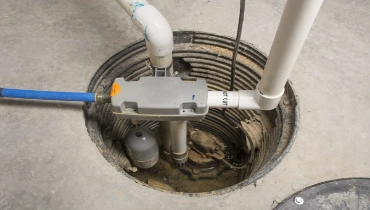
If you have a sump pump in your home, you know it is essential to keep certain areas dry so moisture doesn’t buildup, which could lead to mould and/or mildew. And considering the average cost to replace a sump pump is about $800, replacing it can be pretty costly too! But with a little maintenance you can keep your unit running smoothly and more money in your pocket.
Although a sump pump is not a complicated piece of equipment it does require routine maintenance to keep it running efficiently throughout the year. And when warmer weather arrives, your sump pump may be working a little extra to keep up with melting snow and/or wet spring weather.
Since the weather is a little warmer, spring is a great time to start your sump pump maintenance. Because there are quite a few things to remember about maintaining your sump pump, it’s a good idea to create a sump pump maintenance schedule. In this article we’ll provide some tips and advice to help keep your pump working properly, including how to develop and maintain a quarterly and annual maintenance schedule.
Safety First
First and foremost, you should always make sure that you stay safe while performing maintenance on your sump pump. Sump pumps operate using electricity and they are in and near water which can create a potential hazard situation. To be safe, follow this step-by-step process:
- Unplug the sump pump or turn off the circuit breaker that powers it.
- Always wear protective gloves and goggles when working with the dirty water in your sump pump.
- Gather any cleaning supplies including a scraper, bucket, and plastic sheet to cover the area where you will be working.
- Waterproof rubber sole shoes or booths are also recommended.
Quarterly Maintenance
Once your safety procedures have been implemented, you can then start your maintenance work. Quarterly maintenance is important because it provides an opportunity to periodically inspect your pump to ensure it is in good working condition. Although the average lifespan of a sump pump is about 10 years, this type of scheduled maintenance can help identify and address a potential issue before it becomes a bigger problem, which could extend the life of your pump. So quarterly maintenance is essential to help you get the most (in terms of years) out of your sump pump.
Ensure Power Connected and Working
Most homeowners don’t check to see if their sump pump is working on a daily basis. Many just assume that if the area isn’t flooded, the pump is doing its job. While this is partially true, it’s still important to make sure your pump is plugged in, with power flowing to the outlet. If you haven’t heard your pump start up in a while, it’s a good idea to use an electrical tester to ensure electricity is flowing to the outlet it uses. If there is no power to the outlet, check the breaker to see if it has been tripped. If the breaker was not tripped and there is still no power to the outlet, contact a local electrician to check it out.
Testing the System
It’s also good to occasionally check on how your pump is operating. When the sump pump is plugged in, dump a bucket of water into the area where your pump is located. A single bucket of water should be enough to activate the pump, but you might have to add a second bucket, depending on the pump setting. Make sure your pump turns on and properly drains the water from the area. Listen for any unusual noises coming from the pump that might indicate there is a problem.
Clean Inlet Screen
The inlet screen on the sump pump is meant to keep larger debris and particles out of the sump pump. If the screen gets clogged, it will also keep water from getting sucked into the pump and removed from your home. To clean the screen, turn the power off to the sump pump, and remove the pump from the area. Remove the inlet screen and clean it with a wire brush until all debris has been removed. Replace the screen and perform a practice run (using the testing process described above).
It's important to perform these basic checks every spring, summer, fall, and winter to ensure your pump is working properly and ready when you need it.
Annual Maintenance
Since the weather is warmer, but not too hot, spring is a good time to perform some of the more involved sump pump maintenance. Although these maintenance tasks are slightly more complicated and in-depth, it is important to perform them at least once a year.
Cleaning the Pump
Properly cleaning your pump is extremely important. Following these steps can help extend the life of your pump:
- After checking to make sure your sump pump is off, disconnect the pump from the discharge pipe.
- Wrap your pump in plastic to prevent drips and take it to an area outside to clean. Using your garden hose, rinse off any dirt or sludge from the surface of the pump. A plastic scraper or putty knife might be needed to loosen, clean and remove any caked-on material from the sump pump. Once it is clean, leave it in a safe place to dry.
- Drain any standing water from your sump pit using a shop vac.
- If you have a check valve that can be disassembled, carefully disassemble and allow any water to drain out of your check valve, then remove it. Rinse the valve thoroughly with water, then dry and reassemble it.
- Once thoroughly dry, reattach your pump to the discharge pipe.
- Plug your unit back in. You’re all done!
Lubricate the Pumps Bearings
Not all sump pumps need to have their bearings lubricated. Check your owner’s manual or perform an Internet search using your pump’s make and model number to find the manual for your pump online. This will help you determine if lubricating the bearings is necessary. If so, follow the instructions provided in the owner’s manual.
Clean the Sump
After cleaning your pump and lubricating, if necessary, the bearings, this is a good time to clean the sump pit. With everything already out of the sump, you should have easy access to clean it. Use a shop vac to remove any excess water and wipe down the inside of the pit. Make sure to remove any large pieces of debris during the cleaning process.
If possible, you may even want to remove the sump completely and check underneath it to ensure it’s properly supported. Once you’re finished, reinstall the sump, the pump, and perform a test run to make sure everything is working as it should.
Do You Have a Backup Battery?
While having a backup battery isn’t always necessary, it’s a good investment and added safety measure for ensuring your pump keeps running when needed. Power outages can be frequent in certain parts of Canada, especially during stormy weather. A battery backup can help keep your pump running at a time when you need it most. Check out this link to learn more about a battery backup or installing a backup sump pump.
Pro Maintenance and Advice
Your sump pump can be a vital piece of equipment to prevent flooding in and around your home. With some well-timed maintenance you can ensure your pump continues to work properly and it is ready to get the job when needed.
If you think a backup battery is what you need, or you would like to have your sump pump checked out by a pro, call the local experts at Mr. Rooter. We can install a battery backup for you, check and clean your sump pump, and setup a routine maintenance plan that ensures your pump stays in good working condition all year long. To get started, give us a call or schedule an appointment online today!

